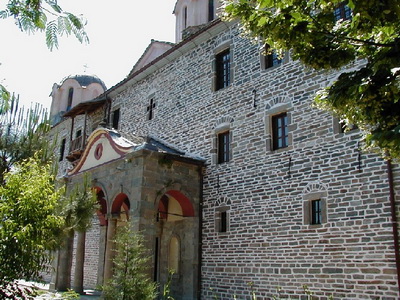

The Athos peninsula lies in the South-East
of Europe in the Northern Aegean Sea. It constitutes, in accordance with its
ancient privileged status, an independent part of the Hellenic State - a unique
monastic state. Athos, according to its ancient tradition, permits no access
to women, and the monks live a simple life without comforts such as private
cars, TV etc. From the moment that monasticism made its appearance on Athos
on about AD 800, until the fall of the Byzantine Empire in 1453, the emperors
never ceased to provide it with moral support and economic aid. Today it houses
about 2200 monks from Greece, Russia, Romania, Serbia, Bulgaria, the U.S.A.
France, Germany and other countries.
The coenobitic Monastery of Koutloumousiou is situated on the NE side of Mount Athos on a green hillside beside the medieval township of Karyes (the small monastic capital of the Athonite citizenship, where the representatives of the 20 monasteries meet), where nature has striven to offer a unique model of magnificence and beauty of form.
HISTORY
Koutloumousiou Monastery took
part in all the spiritual and cultural movements of the East during the ages,
but also suffered many upheavals: the Fourth Crusade (1204), the depredations
of Catalans (1307-1309), the raids launched by the Turkish pirates (14th c.),
the aggression of the Ottoman rule (1424-1912), earthquakes and fires.
The earliest history of the monastery dates back to the eleventh century. In a document that survives from 1169, the Koutloumousiou monastery is said to have already been in existence for a long time. The founder of the Monastery is known as Saint Koutloumousis, "the Chosen and Beloved of God, that most excellent in all things and virtuous Koutloumousis," in the words of the Protos Isaac (14th century). Its first benefactor was the Byzantine Emperor Alexios the First Comnenos (1081-1118).
Abbot Chariton took over the reins of the Monastery a little before 1362. Through Abbot Chariton's fervent appeals and intercessions to the rulers of Hungary and Wallachia, financial assistance, and land grants were secured-the Monastery was restored. The net result of this relationship with the rulers was the profound influence exerted upon the spiritual life of the Danubian provinces by the Hellenic culture. Chariton was appointed Metropolitan of Hungary and Wallachia, while he continued to carry out his duties as Abbot of his Monastery.
In 1393, the Ecumenical Patriarch Antonios proclaimed Koutloumousi a Patriarchal Monastery. This meant that it now enjoyed the care and protection of the Bishop of the Imperial City, and was free from interference, or influence, from any secular or regional ecclesiastical power. Similarly, additional freedoms were granted by the royal Chrysobulls, the royal charters, which extended 'royal' status to the monasteries. This privileged status was also aknowledged-for the most part- by Ottoman rulers. In the centuries that followed, the Monastery was free to enjoy a course of steady growth and prosperity. Consequently, by 1574, the monastery rose to occupy sixth position in the hierarchical ranking of the Athonite monasteries.
During the dark ages of the Ottoman occupation, Koutloumousi maintained the faith of enclaves of the enslaved Greek people and served as a rallying point to foster independence for its dependencies in many regions of the Greek mainland, the Aegean islands and even Slatina, Romania. Monks were also dispatched as priests to serve the thriving Greek communities of central Europe, especially those in Vienna. During the 17th and 18th centuries, the Monastery had to rely exclusively on the support of pious Greeks. In 1767, Matthew, Patriarch of Alexandria, a brother of the monastery, rebuilt the beautiful refectory of the monastery, which burned down earlier. In the early 19th century, Bartholomew, one of the Monastery's outstanding brothers, taught in Venice and Smyrna and authored a prolific amount of work.
In the mid-19th century, the Monastery faced new ordeals, thanks to the new expansionist policies of the Russian Empire. In 1860, an attempt was made to impose a Russian identity upon the Monastery. The fathers, mainly British citizens from the Ionian Islands, took advantage of their citizenship by covering the central gate of the Monastery with the British flag, which caused fear within the Turkish garrison that arrived to impose by force a new administration. At the same time the Abbot Ioasaph asked for the intervention of the British Ambassador to Constantinople H. Bulwer and eventually the danger was averted.
At this time a fire reduced the northern wing of the Monastery to ashes. The priest-monk Meletios, distinguished for his virtue and administrative talents, travelled as far as Russia, central Europe and England with letters from the Monastery seeking financial support. He was able to secure financial aid to restore the northern wing.
In 1863 the Romanian governor Alexander Cuza confiscated the lands and dependencies of all the Athonite monasteries including those of Koutloumous Monastery despite the efforts of the British Ambassador H. Bulwer, who had always been in defense of the monks.